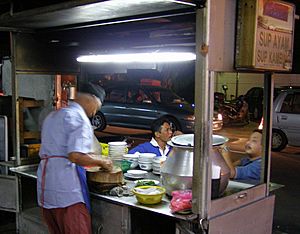Sup kambing facts for kids

Sup kepala kambing, goat's head soup served in Indonesia.
|
|
| Alternative names | Sop kambing |
|---|---|
| Type | Soup |
| Course | Main course |
| Associated national cuisine | Indonesia, Malaysia, Singapore, |
| Serving temperature | Hot |
| Main ingredients | Mutton or goat meat |
Sup kambing or sop kambing is a tasty Southeast Asian mutton soup. You can find it in countries like Brunei, Indonesia, Malaysia, and Singapore. This soup is made with goat meat, tomatoes, celery, spring onions, ginger, and candlenuts. Its broth usually has a yellowish color.
Sup kambing is very popular. Many similar goat meat soup recipes exist across Malaysia, Indonesia, and Singapore. In Indonesia, it is often linked to the Malay people of Medan, the Betawi people, and the Madurese people. It's also common in Java. However, Javanese people often prefer to cook goat meat as tongseng or a soupy gulai.
Traditionally, sup kambing is widely enjoyed during Eid al-Adha. This is an Islamic festival where lots of goat meat is shared among people. In Malaysia, sup kambing is also connected to the Muslim Malaysian Indian community. Many believe it first came from India. In Singapore, the dish is also popular with the Muslim Indian community.
Where Did Sup Kambing Come From?
Even though sup kambing is popular in Maritime Southeast Asia, its origins might be from Arab and Muslim Indian travelers. People believe sup kambing came from Arab traditions. Arab migrants brought it to the Malay Archipelago between the 18th and 19th centuries. This was during the time of the colonial era.
These Arab settlers liked and shared goat and lamb meat. Because of this, several dishes influenced by Arab and Muslim Indian cooking became popular. These dishes appeared in Sumatra, the Malay peninsula, and Java. Around the same time, other goat or mutton dishes like sate kambing, gulai kambing, and tongseng also showed up in Java.
Early Arab immigrants settled in coastal towns in Sumatra and Java. They influenced the local cultures, including the Malays, the Betawis in Jakarta, and the Javanese and Madurese in East Java. Local people adopted sup kambing. It became linked to the Islamic festival of kurban (Eid al-Adha). During this festival, many goats are prepared and shared.
Because of this, even though it has Arab roots, sup kambing in Indonesia is now more connected to Malay, Madurese, and Betawi cooking. Indonesian sup kambing often uses carrots, tomatoes, and sometimes potatoes. This suggests some European influence, possibly from Portugal or the Netherlands. Tomatoes and potatoes were not in Southeast Asia until Europeans brought them from the Americas around the 17th century. The sup kambing from Medan in North Sumatra is more like the Malaysian version. This is because it often comes from Muslim Indian culture.

In the Malay Peninsula, which includes Malaysia and Singapore today, the most famous version is sup kambing Mamak. Many believe this version was created by the Muslim Indian community there. It uses many typical Indian spices. There isn't an exact same soup in India. However, the spices and cooking style clearly show Indian influence.
The most famous sup kambing in Singapore is sup tulang merah. This dish was created by Baharudeen, Abdul Hameed, and Abdul Kadir. They were migrants from a village called Thopputhurai in Tamilnadu. These three shops are located at Jalan Sultan, Beach Road. Native Malays in both countries have also adopted this dish.
What Goes Into Sup Kambing?
There are many ways to make sup kambing. However, there are two main types of sup kambing traditions. The Indonesian version mostly comes from Arab and some Dutch influences. The Malaysian and Singaporean version is often called sup kambing Mamak. This version comes purely from Muslim Indian influences.
Other main differences include:
- The Malaysian and Singaporean version has chunks of goat meat in a yellowish, thick, and oily broth. It is rich in spices.
- The Indonesian version often includes goat meat with bones, like ribs or leg bones. It has a lighter broth and balanced spices. It also contains slices of vegetables such as tomato, leek, celery, carrot, and sometimes potato.
A simple sup kambing recipe uses goat meat, slices of tomato, leek, and celery. It also uses ground spices like ginger, pepper, garlic, shallot, and salt. More complex recipes might add more spices. These can include cardamom, cinnamon, candlenut, nutmeg, clove, and star anise. These extra spices add more aroma and taste.
Different Kinds of Sup Kambing
In Indonesia, the soup is made with a rich, savory broth. It uses spices and ingredients similar to another Indonesian favorite, sop buntut (oxtail soup). Regular sop kambing uses goat meat and its ribs.
However, in Indonesia, there are more specific types of sop kambing:
- Sop kepala kambing: This soup uses offal from a goat's head. This includes its tongue, ear, lips, cheek meats, eyes, and sometimes even the brain.
- Sop kaki kambing: This specific sup kambing uses goat's trotters, which are its feet.

